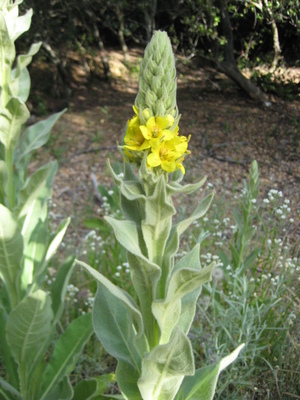Description and Habitat of Mullein
Mullein (Verbascum thapsus) is an herb that is native to Europe and grows in temperate regions in the United States. It prefers a sunny, dry location and is often found in fields and roadsides. Mullein is a biennial with a two-year life cycle. The first year it appears as a low-growing rosette, and the second year it produces a stalk up to 10 feet tall with a flowering spike at the top. Mullein leaves are thick and fuzzy, and can be very large, often over a foot in length. Small, bright yellow flowers grow at the top of the spike.
Common names of mullein include flannel leaf, velvet plant, donkey’s ears and candlewick plant. The dried stalk has been used since ancient times as a torch.
Medicinal Properties and Uses of Mullein
Mullein is an expectorant that loosens phlegm and helps to eliminate congestion of the lungs and respiratory tract. It is also anti-inflammatory and demulcent, soothing to mucus membranes. Mullein leaves have traditionally been used for respiratory conditions including bronchitis, asthma and coughs. Infuse 1 tablespoon of crushed, dried leaves in a cup of boiling water and drink up to 4 cups throughout the day. Tea can also be made from the dried or fresh flowers, which have a mild sedative effect and are helpful to calm spasmodic coughs.
Infused oil made of mullein flowers has an antibacterial action and is an effective remedy for earaches. Mullein oil can also be used to relieve ear mites in animals.
Mullein root has diuretic properties and is used for urinary tract infections; it strengthens the trigone muscle of the bladder and aids in preventing incontinence and bedwetting. Mullein root is reportedly effective for backaches and injuries of the spine when taken as a tincture.
How to Harvest Mullein Flowers
Mullein flowers should be harvested early in the morning, because they begin to wither and dry up as soon as the hot sun strikes them. New flowers open every day along the spike at the top of the mullein plant. To harvest, grasp a flower near the base and gently pull to the side. The flower will slide out easily, but pulling too hard will cause the petals to tear off.
To make mullein flower infused oil, wilt the fresh flowers for a few hours to remove some of the water, and combine with an equal volume of olive oil in a glass jar. Cap tightly and leave in a warm place for four weeks, shaking daily, and then strain out the flowers.
Cautions and Contraindications
Mullein is considered safe, and there are no reported contraindications. Those with allergies or particularly sensitive skin may be bothered by the tiny hairs, and teas made from the leaves and flowers should be filtered through a fine cloth or coffee filter.
http://www.herbcraft.org/mullein.html
http://www.altnature.com/gallery/mullien.htm
Moore, Michael. Medicinal Plants of the Mountain West, Santa Fe, Museum of New Mexico Press, Santa Fe, 2003.


